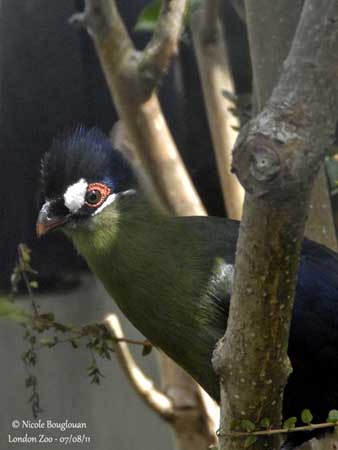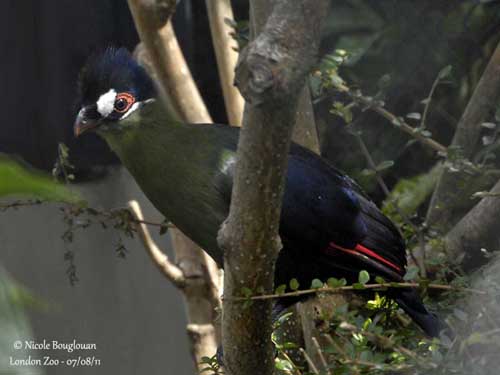
Fr: Touraco de Hartlaub
All : Seidenturako
Esp : Turaco de Hartlaub
Ital : Turaco di Hartlaub
Nd : Hartlaub-toerako
Sd : Hartlaubturako
Text and pictures by Nicole Bouglouan
Sources :
HANDBOOK OF THE BIRDS OF THE WORLD vol 4 by Josep del Hoyo-Andrew Elliott-Jordi Sargatal - Lynx Edicions - ISBN: 8487334229
BIRDS OF AFRICA SOUTH OF THE SAHARA by Ian Sinclair and Peter Ryan - Princeton University Press Princeton and Oxford - ISBN: 0691118159
BirdLife International (BirdLife International)
Hartlaub’s Turaco
Tauraco hartlaubi
Musophagiforme Order – Musophagidae Family
BIOMETRICS:
Length: 43 cm
Weight: M: 210-270 g – F: 195-275 g
DESCRIPTION:
The Hartlaub’s Turaco is endemic to E Africa and relatively common throughout its range.
The adult has green chin, throat, cheeks, neck, mantle and breast. The lower back, wings and tail, are violet-blue. The rump is darker, mostly blue-black.
On the wings, most of primary and outer secondary flight feathers are bright red, conspicuous in flight.
On the underparts, thighs and belly are dull blackish with greenish wash.

The head shows distinctive pattern. Forehead, bushy rounded crest and nape are glossy blue-black. There is a conspicuous white patch in front of the eye. A white line runs below the eye, from the gape to the ear-coverts. The black lores extend in narrow black line immediately beneath the eye, just above the white one. The eye is surrounded by a broad, bare, red orbital ring, broader behind the eye.
The bill is blackish and red. The eyes are dark brown. Legs and feet are black.
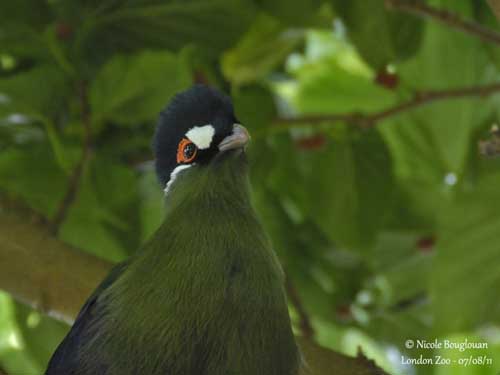
Both sexes are similar.
The immature resembles adults.
The chicks are covered in black down at hatching.
VOICE: SOUNDS BY XENO-CANTO
The Hartlaub’s Turaco utters high-pitched squawk and loud, guttural series of barking calls “kwa, kak, kwak-kwak, kwak”.
HABITAT:
The Hartlaub’s Turaco is found in montane evergreen forest, up to 1500-3200 metres of elevation. It frequents gardens with trees in suburban areas, especially around Nairobi.
RANGE:
The Hartlaub’s Turaco occurs around the Kenyan Highlands, and extends into E Uganda and N Tanzania.
BEHAVIOUR:
The Hartlaub’s Turaco is mainly a fruit-eater. It takes fruits and berries from several plant species. This bird is able to eat the poisonous fruits of Acokanthera longiflora, locally named “Poison Bush” or “Bushman’s poison”.
The birds living in suburban gardens often feed on exotic fruits from Cotoneaster of Rosaceae family.
But they also catch insects such as moths and beetles, and caterpillars.
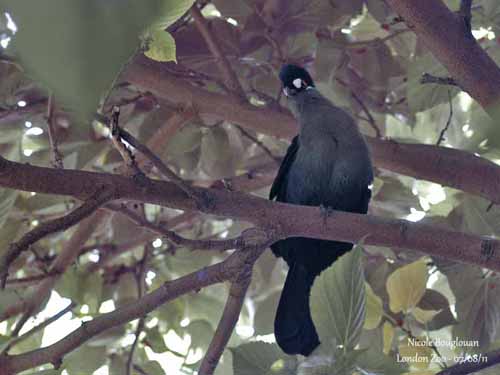
The Hartlaub’s Turaco climbs easily from branch to branch, but it is often hidden in the foliage in tree canopy. This is a shy but gregarious species. They are usually seen in pairs or family groups, and they gather in flocks of up to 20-25 at fruiting trees.
They sometimes come to the ground for bathing and drinking. They appear very agile when moving through the canopy.
The Hartlaub’s Turaco’s daily activities are regular, starting by loud calling at dawn, followed by feeding activity in the early morning. In the middle of the day, they bathe, preen and sunbathe with raised feathers and partially spread wings and tail. During the hottest hours, they rest in the shade within the forest.
At the end of the day, they utter again their loud calls and move to the roosting sites in tall trees.
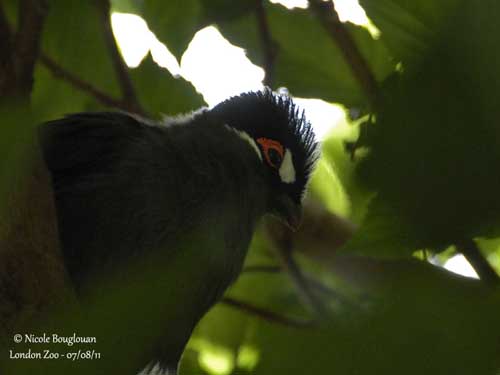
During the breeding season, the pair defends strongly the territory.
At the beginning of the rainy season, the courtship displays include much calling. Chases from tree to tree are frequently observed. Mates perform mutual feeding too.
The displays involve opening and closing of the bill, crest raising and lowering, and the birds move their heads to enhance the bright pattern. They also bow, flick the tail and spread the wings to expose the bright red patches.
This species is sedentary throughout the range.
FLIGHT:
As all turacos, the Hartlaub’s Turaco is a poor flier. However, when they take off, they form a single file, and perform a short downward glide followed by some fast wing beats, in order to reach the next tree. Then, each bird climbs to the canopy by hopping and bounding.
REPRODUCTION:
The breeding season occurs between April and December, and mainly during periods of heavy rainfall.
The Hartlaub’s Turaco builds a shallow, flimsy platform among the thick foliage and in dense creepers, at about 3-8 metres above the ground.
The nest is made with twigs and lined with finer ones.
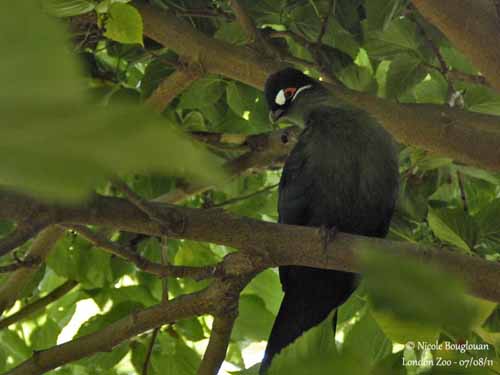
The female lays two rounded white eggs, and both adults incubate during 16-18 days. At hatching, the chicks are covered in black down. The parents feed then frequently with caterpillars and regurgitated fruit pulp.
About 17-18 days after hatching, they are able to climb into the nesting tree, and can fly at 28-30 days of age.
DIET:
The Hartlaub’s Turaco feeds mainly on fruits and berries from several plant species. It consumes the large, poisonous fruits of Acokanthera longiflora, and exotic fruits in suburban areas.
It also catches insects and caterpillars.
PROTECTION / THREATS / STATUS:
The Hartlaub’s Turaco is fairly common in its range.
The Tanzanian populations have suffered heavy trapping for pet trade, now forbidden without a permit.
This species is not currently threatened.
